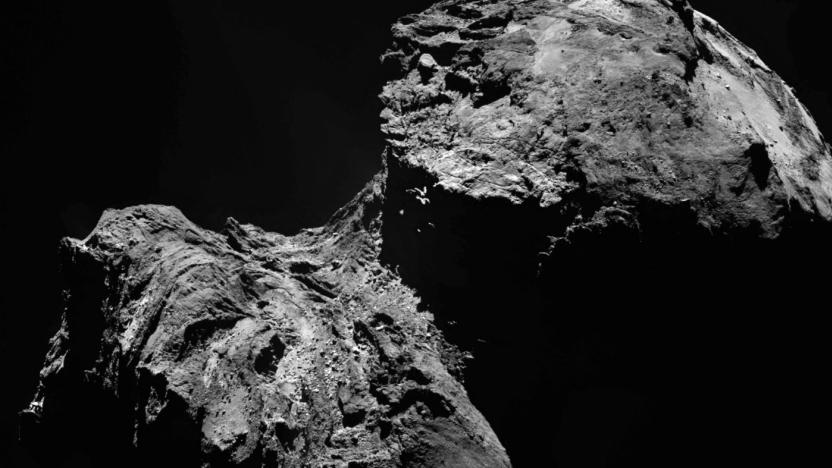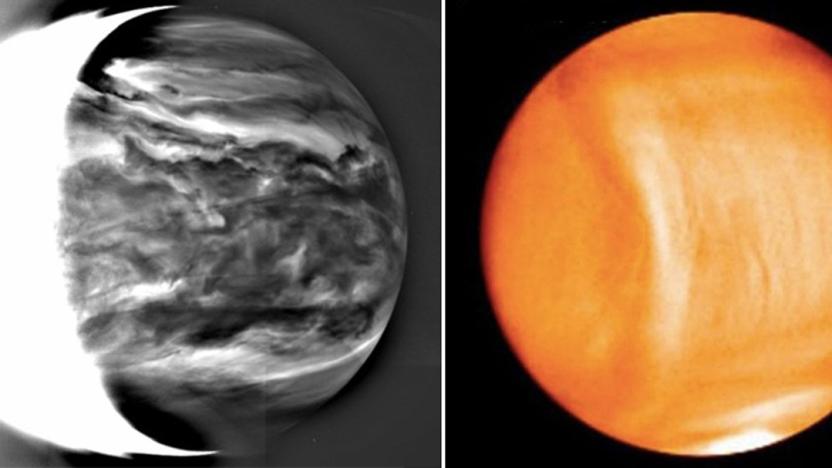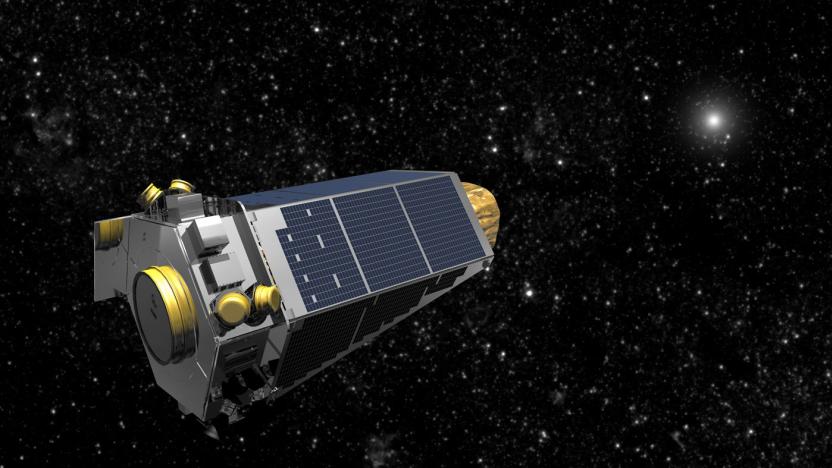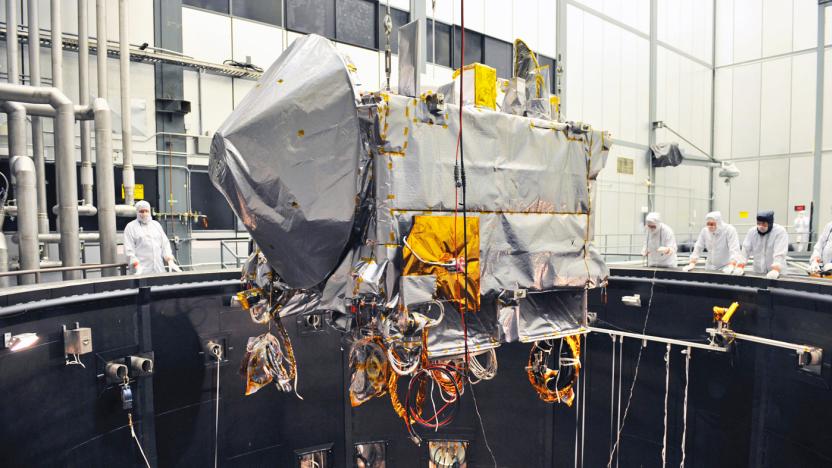spacecraft
Latest

ICYMI: NASA hunts for life hidden in an asteroid
try{document.getElementById("aol-cms-player-1").style.display="none";}catch(e){}Today on In Case You Missed It: NASA is planning a trip to get a sample of the large asteroid Bennu and see if any organic materials can be found on it. If you remember hypercolor t-shirts, you'll want to know about an air pollution sensing shirt that changes color and patterns when carbon monoxide, radioactivity and particle pollutants are detected. You'll want to see this video from Japan showing a volcano's eruption with a thunderstorm inside. As always, please share any interesting tech or science videos you find by using the #ICYMI hashtag on Twitter for @mskerryd.

Rosetta will crash into its comet and die on September 30th
Farewell, young spacecraft. The European Space Agency's Rosetta probe has been surveying Comet 67P (or Churyumov-Gerasimenko) for the past 12 years, and on September 30th it will crash into the space rock and end its mission. Rosetta is nearing the orbit of Jupiter, which means it's running short on solar power and bandwidth required to downlink necessary data.

NASA is building the next Mars rover in mixed reality
I poked my head inside NASA's latest Mars rover. During a mixed-reality demonstration at the Jet Propulsion Laboratory (JPL) in Pasadena, as soon as I strapped on a HoloLens, a vibrant holographic vehicle popped up in front of me.

SpaceX wants to land on Mars as early as 2018
SpaceX was already pretty ambitious when it signaled plans to send a Dragon capsule to Mars, but the originally hoped-for 2022 launch was apparently not quick enough. The company has announced plans to send an unmanned Dragon to Mars "as soon as" 2018 -- that's just a couple of years from now, folks. It also expects Red Dragons to define the "overall Mars architecture." Other details are scant at I write this, but it's already clear that SpaceX wants to try interplanetary travel as quickly as possible.

NASA pours $67 million into solar electric spacecraft engines
NASA is big on solar electric propulsion (the Dawn spacecraft uses it, for instance) for a good reason: while the engines aren't powerful, they supply thrust for a very long time before giving up the ghost. And it now looks like the agency is ready to double down on that super-efficient tech. It just awarded a $67 million, 3-year contract to Aerojet Rocketdyne in hopes of developing an advanced solar electric propulsion system. The new technology could deliver twice as much thrust, and would be up to 10 times more efficient than chemical engines -- both big deals for deep space missions.

Venus probe's first detailed results reveal strange clouds
Japan's Akatsuki spacecraft almost didn't make it into orbit around Venus, but it's clear that the effort to put it back on track is paying off. The Japan Aerospace Exploration Agency recently obtained the first detailed scientific results from its once-wayward probe, and it's clear that we still have a lot to learn about our closest planetary cousin. For one thing, its clouds don't entirely behave the way researches expect. Infrared images of its dense, multi-layer cloud layers suggest that cloud formation is more complex than once thought, and the unusual bow-shaped cloud formation (shown at right) appears to rotate in sync with the surface, not the atmosphere. It's possible that features on the ground are having a strong effect on the sky.

NASA is funding asteroid spaceships and other far-out concepts
NASA's annual National Innovative Advanced Concepts (NIAC) program awards money to some of the craziest space projects you'll ever see, and this year is no different. The space agency has just announced the 13 concepts that made it through Phase I, and one of the most interesting entries plans to transform whole asteroids into spaceships. It's called Reconstituting Asteroids into Mechanical Automata or Project RAMA. The concept is the brainchild of Jason Dunn, co-founder of Made In Space, which developed the 3D printer that's aboard the ISS.

'Starshot' plan gets probes to Alpha Centauri in your lifetime
The concept of exploring other star systems with probes (and not just telescopes) has proven elusive for one good reason: even the fastest spacecraft would take 30,000 years just to reach Alpha Centauri, our closest neighboring star. However, investor and space project enthusiast Yuri Milner thinks it's possible to do better. He and physicist Stephen Hawking have launched Breakthrough Starshot, a $100 million program that aims to get probes to Alpha Centauri within a generation. If all goes well, the observers would reach the relatively close-by system (4.4 light years away) within 20 years of leaving Earth.

NASA's Kepler space telescope is back in good health
You can breathe again, space fans -- NASA has returned the Kepler space telescope to normal after a nerve-wracking weekend spent in an emergency mode. It's still not clear what triggered the crisis (a planned maneuver wasn't at fault), but the team plans to double-check systems for the next week before carrying on with its extended mission. Let's just hope this doesn't happen again. Kepler barely managed to survive its first big incident, and there's no guarantee that it'll be so lucky the third time around.

NASA starts drop testing Orion with a dummy crew on board
The Orion capsule's first manned mission isn't scheduled to take off until 2023 at the earliest. NASA is already preparing for it, though, and has begun a series of water impact tests using a mockup of the spacecraft with a dummy crew on board. Engineers at the Langley Research Center dropped the mockup in a 20-foot-deep Hydro Impact Basin from 16 feet above the surface for the first test out of nine.

NASA's asteroid explorer faces tests that simulate space
Before NASA's OSIRIS-REx spacecraft can visit an asteroid to collect samples, it'll have to run a tough gauntlet. The probe is undergoing a 22-day thermal vacuum test that will see whether or not it can function in the unforgiving conditions of space. On top of working in an atmosphere-free environment, it'll face temperatures as cold as -274F and the periodic heat of a simulated Sun. So long as OSIRIS-REx makes the grade, it'll largely be ready for its September launch and the epic 7-year journey toward the asteroid Bennu.

ICYMI: Laser-powered spacecraft, upgraded Atlas bot and more
#fivemin-widget-blogsmith-image-139655{display:none;} .cke_show_borders #fivemin-widget-blogsmith-image-139655, #postcontentcontainer #fivemin-widget-blogsmith-image-139655{width:570px;display:block;} try{document.getElementById("fivemin-widget-blogsmith-image-139655").style.display="none";}catch(e){}Today on In Case You Missed It: A professor from California is working on a plan to use photonic propulsion to get a spacecraft to Mars within 72 hours. It would use get the craft off of earth with the power generated by photons leaving a laser.

NASA wants to send your art on a round-trip to space
NASA will take your artworks on a spacecraft this year. The exploration agency has launched a new We The Explorers campaign that's encouraging people to send in a piece of art for OSIRIS-REx, the first American mission that's expected to bring back a small sample of asteroid Bennu for scientists to study on Earth. The submissions, loaded on a chip, will be carried on board the vessel in September.

Juno sets distance record for solar-powered spacecraft
Aided by its enormous solar array, NASA spacecraft Juno has set a record as the most distant solar-powered space explorer. The four ton "armored tank" craft hit 493 million miles yesterday on its way to Jupiter, passing Rosetta's 492-million-mile mark. With a 30-foot-long array and 18,698 solar cells, it's able to profit from what little sunlight hits it. "Jupiter is five times farther from the sun than Earth, and the sunlight that reaches that far out packs 25 times less punch," said Juno project manager Rick Nybakken.

Philae comet lander has likely gone silent for good
If you were hoping for a happy ending to the Philae comet lander's frequently perilous adventures, you might be disappointed. The German Aerospace Center reports that a last-ditch attempt at contacting the lander has so far gone without a response. Either it doesn't have enough power to follow through, or it didn't get the commands in the first place. There will still be "contact opportunities" until January 21st (when the Rosetta spacecraft flies to the comet's southern hemisphere), the Center says, but it's not expecting to hear back.

Here's the Cygnus spacecraft launching in glorious 4K
Orbital ATK's Cygnus spacecraft, laden with more than 7,000 pounds of supplies destined for the International Space Station, finally got off the ground earlier this week and NASA was there to capture the successful launch in 4K ultra high definition. The space agency utilized an array of six UHD cameras positioned around Cape Canaveral AFS to document the event and has posted the footage to its newest YouTube channel, NASA TV UHD. This launch marks the first flight of the Cygnus spacecraft since a disastrous attempt in October, 2014 which saw the Antares rocket carrying it explode shortly after takeoff.

Japan's Venus probe is about to take another shot
Japan tried and failed to get its Akatsuki ("Dawn") probe into Venus' orbit back in 2010, and the spacecraft has been stuck orbiting the Sun ever since. However, the team is about to get another chance at completing its intended mission. Controllers plan to fire the ship's engines on December 7th at 9AM Japan time (December 6th 7PM ET), hopefully giving it just enough of a push to (eventually) get it circling around Venus. They'll know whether or not the burn worked properly within a few hours, but it'll take a few days before they know if they're in orbit.Update: The attempt is happening in just a few minutes, for live updates you can watch a stream of the data and control center, or follow Emily Lakdwalla on Twitter.

Scientists built a spacecraft that converts junk to fuel
It turns out that the sky is full of space debris, which poses a threat to craft and satellites orbiting Earth. A team of scientists at Tsinghua University in Beijing, China have come up with a way to remedy this. They've developed a spacecraft that collects the debris in a wide-cast net and uses it as fuel to propel itself forward. This technically means it could keep cleaning forever, unless an unforeseen event brings its efforts to an untimely end. Lasers have been developed for eliminating larger pieces of space junk, however aren't designed for smaller bits that are harder to locate and track. That's where Lei Lan and her team come into the picture.

Astronomers find pure oxygen leaking from Rosetta's comet
European Space Agency astronomers, with the help of the Rosetta spacecraft, have made a remarkable discovery that could fundamentally alter our understanding of how the solar system formed. They have detected large amounts of pure oxygen (O2) leaking from comet 67P/Churyumov-Gerasimenko. Oxygen is a pretty common element, but because it reacts so easily with other elements it's almost always found in mixed molecules like carbon monoxide (CO), carbon dioxide (CO2) or water (H2O).

ICYMI: Mousetrap for memory, balloon space launch and more
#fivemin-widget-blogsmith-image-30194{display:none;} .cke_show_borders #fivemin-widget-blogsmith-image-30194, #postcontentcontainer #fivemin-widget-blogsmith-image-30194{width:570px;display:block;} try{document.getElementById("fivemin-widget-blogsmith-image-30194").style.display="none";}catch(e){}Today on In Case You Missed It: A virtual reality simulator putting mice through a pretend maze is analyzing memory formation that should benefit humans. A newish space launch company plans to inflate stadium-sized balloons for a gentle flight to the stratosphere, with actual flights scheduled for 2017. Meanwhile researchers built a tractor beam using high-amplitude sound waves to move small objects, which is just as cool as it sounds.







